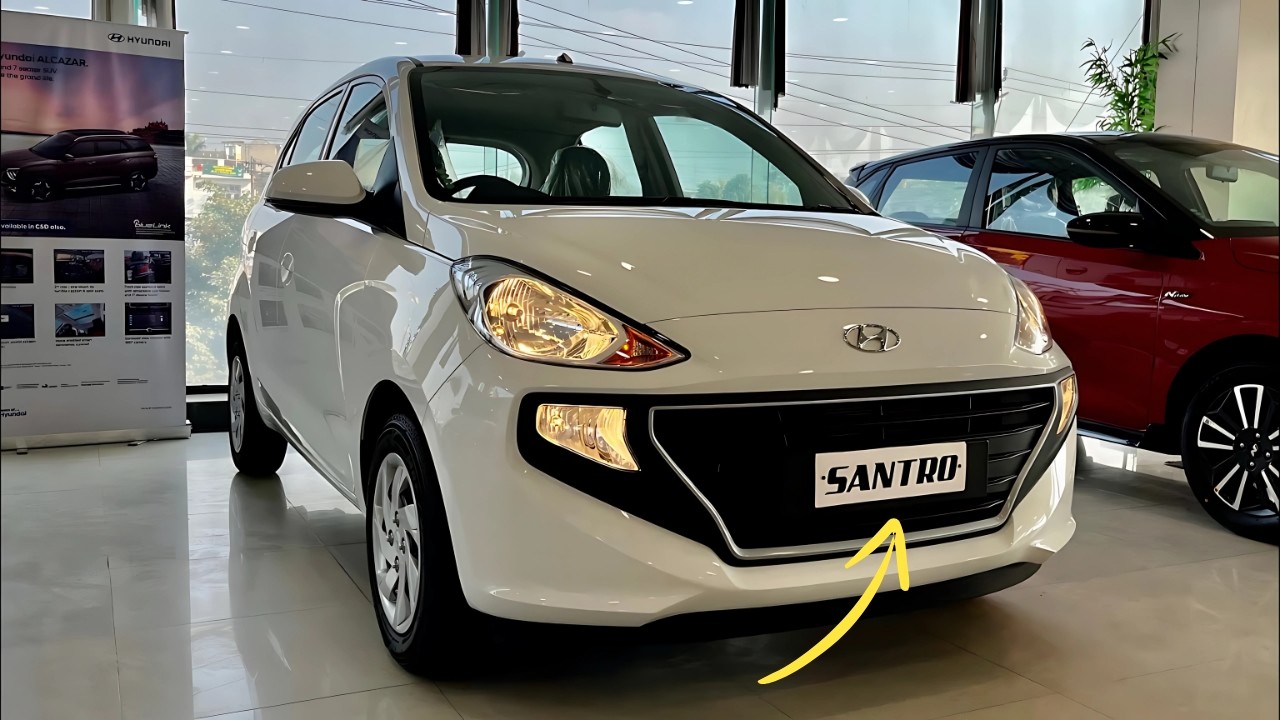Hyundai Santro: In the annals of India’s automotive history, few vehicles have left as indelible a mark as the Hyundai Santro. This unassuming hatchback didn’t just introduce a new brand to the Indian market; it fundamentally altered the country’s automotive landscape, challenging established giants and redefining customer expectations.
From its quirky “tall boy” design to its association with Bollywood superstar Shah Rukh Khan, the Santro’s journey represents more than just sales figures—it embodies the story of how an outsider brand became a household name in one of the world’s most competitive automotive markets.
Hyundai Santro: The Arrival: Breaking into a Maruti-Dominated Market
When Hyundai Motor Company set up its manufacturing plant in Sriperumbudur, Tamil Nadu, in 1996, the Indian automobile market was virtually a Maruti Suzuki monopoly.
The Japanese carmaker controlled nearly 80% of the passenger car segment, with Tata, Hindustan Motors, and Mahindra dividing the remaining slices. For a Korean newcomer to even contemplate challenging this established order seemed audacious, if not foolhardy.
Yet, Hyundai’s ambitions were clear. With an investment of $614 million—the largest by any multinational in the Indian automotive sector at that time—they weren’t merely testing waters; they were diving in headfirst.
The stage was set for a David versus Goliath battle, and Hyundai needed a champion. They found it in the Santro.
Unveiled at the 1998 Auto Expo, the Santro arrived with an unconventional silhouette that immediately set it apart. While the Tata Indica’s simultaneous debut may have stolen some thunder, the Santro’s journey was just beginning.
The name itself was a clever marketing choice—derived from Saint-Tropez, the glamorous French coastal city, it aimed to position the car as a “fashionable” option despite its modest pricing.
Design Philosophy: The ‘Tall Boy’ Advantage
The Santro’s most distinctive feature was its tall, upright stance—a design that earned it the affectionate nickname “tall boy.” While initially polarizing (you either loved it or questioned it), this design philosophy offered practical advantages that resonated with Indian families.
The increased headroom and improved visibility made the compact car feel surprisingly spacious inside, addressing a common complaint about small hatchbacks feeling cramped.
Based on the Hyundai Atos sold internationally since 1996, the Santro underwent significant styling modifications for the Indian market.
The quirky front and rear ends were softened to better appeal to local tastes, resulting in a friendly, approachable appearance that balanced distinctiveness with accessibility.
This design approach proved prescient. As urban spaces grew more congested and parking became increasingly challenging, the Santro’s compact footprint combined with relatively roomy interiors offered an ideal compromise.
Its high seating position also addressed India’s often-rough road conditions, providing better visibility and a sense of command that drivers appreciated.
The Shah Rukh Khan Factor: A Marketing Masterstroke
Perhaps no element of the Santro’s success story is more iconic than its association with Bollywood superstar Shah Rukh Khan. This partnership, which began in 1998 and has remarkably endured for over 25 years, represents one of the longest-running and most successful celebrity endorsements in Indian corporate history.
The collaboration almost didn’t happen. In 1997, Hyundai was considering between two popular actors—Shah Rukh Khan and Jackie Shroff—for their brand ambassador role.
Khan, riding high on the success of blockbusters like “Dilwale Dulhaniya Le Jayenge” and “Dil To Pagal Hai,” was initially hesitant to associate with an unknown Korean brand. He reportedly asked pointed questions about Hyundai’s previous market failures and wasn’t immediately convinced.
Hyundai’s multi-part advertising campaign cleverly integrated this initial skepticism. The first ads showed the company pursuing Khan, followed by a second phase where the actor posed questions as a discerning consumer.
The campaign culminated with Khan’s declaration: “I’m convinced”—a tagline that perfectly mirrored the journey Hyundai hoped Indian consumers would take with the Santro.
This marketing approach was brilliantly self-aware. In a market where foreign brands often faced trust deficits, Hyundai acknowledged the skepticism while offering reassurance through a familiar, trusted face.
Khan’s evolution from doubter to enthusiast provided a template for the Indian consumer’s relationship with the brand.
The actor’s mass appeal cut across demographic lines—age, income, geography—aligning perfectly with Hyundai’s ambition to position the Santro as a family car with broad appeal.
Even decades later, Khan has affectionately referred to himself as “the Santro wala,” demonstrating the depth of this association in public consciousness.
Performance and Features: The Right Package
Beyond clever marketing, the Santro delivered substantive advantages that helped it carve out a loyal customer base. Its 1.1-liter, four-cylinder petrol engine was a standout feature at a time when many competitors offered three-cylinder options.
This configuration provided smoother operation, better refinement, and adequate power for both city commutes and occasional highway jaunts.
The Santro’s feature list also helped it punch above its weight class. Power steering—a relative luxury in the small car segment of the late 1990s—became a selling point, as did its relatively comfortable ride quality.
Later iterations added front power windows, air conditioning, and eventually, factory-fitted CNG options that addressed the growing demand for fuel economy.
When the Santro Xing arrived in 2003 as a significant facelift, it brought refreshed styling and additional features that helped maintain the model’s relevance against newer competitors.
This commitment to periodic updates and improvements helped sustain sales figures, with the model regularly achieving volumes of over 60,000 units annually during its prime years.
Cultural Impact: Beyond Transportation
The Santro transcended its role as mere transportation to become a cultural touchstone in India. As the first car for many middle-class families, it represented aspirational mobility and economic progress.
Stories abound of proud Santro owners who had saved for years to make this purchase, viewing it not just as a vehicle but as a symbol of success and upward mobility.
Its presence in popular culture extended beyond the Shah Rukh Khan advertisements. The Santro made cameo appearances in Bollywood films and television shows, further cementing its place in the national consciousness.
In “Chalte Chalte” (2003), Khan’s character drives a Santro, blurring the lines between endorsement and cultural integration.
For Hyundai, the Santro’s success provided a foundation upon which to build an entire brand ecosystem in India.
The goodwill and customer trust generated by the little hatchback transferred to subsequent models like the i10, i20, and Creta, allowing Hyundai to gradually expand upmarket while maintaining its connection with the value-conscious Indian consumer.
The Discontinuation and Brief Revival
After a successful run of over 16 years, Hyundai discontinued the original Santro (by then known as the Santro Xing) in 2014.
The decision reflected changing market dynamics and evolving consumer preferences, as the entry-level hatchback segment faced increasing competition from premium hatchbacks and compact SUVs.
However, the Santro nameplate’s equity proved too valuable to abandon completely. In 2018, exactly 20 years after the original’s debut, Hyundai reintroduced the Santro as an all-new model.
This second-generation version was based on a modified Hyundai i10 platform and featured completely different styling from its predecessor, though it maintained the focus on interior space and value.
Despite initial excitement, the 2018 Santro failed to replicate its predecessor’s success. Several factors contributed to this outcome.
Rising input costs pushed prices higher than initially anticipated, with subsequent increases placing the Santro uncomfortably close to the more premium i10 Nios in Hyundai’s lineup.
Meanwhile, changing consumer preferences toward SUV-styled vehicles like the Maruti S-Presso and Renault Kwid challenged the conventional hatchback format.
After a relatively brief four-year run and approximately 150,000 units sold (compared to the original’s much longer production span), Hyundai discontinued the second-generation Santro in May 2022.
The company cited multiple factors, including rising input costs, decreasing demand for entry-level hatchbacks, and the approaching regulatory requirement for six airbags in all new vehicles, which would have significantly increased costs.
Legacy: The Brand Builder
Though no longer in production, the Santro’s legacy extends far beyond its sales figures. As Hyundai’s inaugural offering in India, it established the foundation for what would become the country’s second-largest car manufacturer.
The company’s journey from unknown foreign entrant to established automotive powerhouse began with this unassuming hatchback.
The Santro demonstrated that with the right product, marketing strategy, and understanding of local needs, even a newcomer could challenge established players in the Indian market.
This lesson hasn’t been lost on subsequent entrants like Kia, MG, and others who have studied Hyundai’s playbook carefully.
For Indian consumers, the Santro expanded expectations of what an affordable car could offer in terms of features, quality, and performance.
By raising the bar, it benefited the entire automotive ecosystem, pushing competitors to improve their offerings and accelerating the overall evolution of the market.
The enduring Shah Rukh Khan partnership established a template for effective celebrity endorsements in India—showing the value of long-term association over quick-change tactics.
This approach helped build genuine brand equity rather than momentary visibility, a strategy that many other brands have since attempted to emulate.
Technical Specifications and Features
Throughout its various iterations, the Santro maintained certain core characteristics while evolving to meet changing regulations and consumer expectations:
First Generation (1998-2014):
-
Engine: 1.1-liter, 4-cylinder petrol producing 63 bhp (initial) and later versions up to 69 bhp
-
Transmission: 5-speed manual, later adding automated manual options
-
Key Features: Power steering, front power windows, air conditioning
-
Later Variants: Factory-fitted CNG option introduced
Second Generation (2018-2022):
-
Engine: 1.1-liter, 4-cylinder petrol producing 69 bhp and 99 Nm torque
-
CNG Variant: 59 bhp and 84 Nm torque
-
Transmission: 5-speed manual or 5-speed AMT
-
Key Features: 7-inch touchscreen infotainment, rear AC vents (segment-first), reverse parking sensors and camera
-
Safety: Driver’s airbag standard, dual airbags on higher trims, ABS with EBD
The second-generation model introduced several segment-first features like rear AC vents, making it competitive on the feature front despite its positioning as an entry-level offering.
Its fuel efficiency ratings ranged from 20.3 km/l for petrol variants to an impressive 30.48 km/kg for the CNG option.
Hyundai Santro: More Than Just a Car
The Hyundai Santro represents more than just a successful product—it embodies a pivotal chapter in India’s automotive evolution.
By challenging conventions, understanding local needs, and maintaining consistent brand communication, Hyundai transformed a quirky “tall boy” into a beloved family member for millions of Indians.
Though no longer rolling off production lines, countless Santros continue to navigate Indian roads daily, testament to the durability and impact of a vehicle that arrived as an outsider but became thoroughly Indian in character and perception.
For Hyundai, the Santro provided not just sales but credibility—a foundation upon which they built an empire.
As India’s automotive landscape continues to evolve toward electrification and new mobility solutions, the lessons of the Santro remain relevant: understand your customer, offer genuine value, communicate consistently, and never underestimate the power of the right product at the right time.
In that sense, the Santro’s influence continues to shape India’s automotive future, long after its production has ceased.

